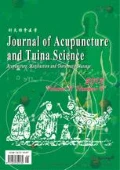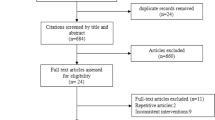Abstract
Objective
To explore the clinical regularities in acupuncture-moxibustion treatment of cancer pain by reviewing the relevant studies published between 1985 and 2017.
Methods
Based on the Chinese Medicine Acupuncture-moxibustion Information Database, quantitative analysis, correlation analysis and Chi-square test were applied to analyze the commonly used acupoints, meridian affiliations and body region distributions, commonly used methods and acupoint correlations, treatment method correlations, the efficacy of acupuncture- moxibustion plus the three-step analgesic ladder for cancer pain, and indicators.
Results
Zusanli (ST 36), Ashi point and Sanyinjiao (SP 6) ranked the top on the list of frequency; points from Bladder Meridian of Foot Taiyang and Stomach Meridian of Foot Yangming were often used; points from the lower limbs and back had high frequencies. The most commonly used treatment method was acupuncture-moxibustion plus medication. Acupuncture-moxibustion plus the three-step analgesic ladder showed certain advantage compared with the two methods used separately, and among the integrated methods, acupoint application plus the three-step analgesic ladder produced the most significant efficacy. It took (44.77±55.54) min for the analgesic effect to act and the effect lasted for (12.81±14.59) h. Numerical rating scale (NRS), visual analog scale (VAS) and Karnofsky performance status (KPS) scores all showed significant changes after interventions (all P<0.01); there was no significant change in the score of quality of life (QOL) after interventions (P>0.05).
Conclusion
Zusanli (ST 36), Ashi point and Sanyinjiao (SP 6) are commonly selected in acupuncture-moxibustion treatment of cancer pain; acupuncture and acupoint application are often used; acupuncture-moxibustion plus the three-step analgesic ladder can boost the treatment efficacy.
概要
目的
回顾 1985 年至 2017 年有关针灸治疗癌性疼痛文献, 探索针灸治疗癌性疼痛的临床规律。
方法
根据 《中医针灸信息库》, 采用计量分析、 关联性分析和卡方检验对针灸治疗癌性疼痛的常用穴位、 腧穴归经和部位分布、 常用治疗方法及穴位关联性、 治疗方法关联性、 针灸结合三阶梯治疗癌性疼痛的疗效及效应指标进行分析。
结果
足三里、 阿是穴和三阴交应用频次最高; 多用足太阳膀胱经和足阳明胃经穴; 下肢穴位和背部穴位使用频次最高。 治疗方法以针药并用为主, 针灸结合三阶梯疗法优于单纯三阶梯疗法和单纯针灸疗法, 其中穴位贴敷结合三阶梯疗效更明显。 癌性疼痛缓解起效时间为(44.77±55.54) min; 缓解持续时间为(12.81±14.59) h。 治疗前后疼痛数字评价量表(NRS)、 视觉模拟量表(VAS)和卡氏行为状态量表(KPS)评分比较, 差异均有统计学意义(均 P<0.01); 生活质量(QOL)评分治疗前后比较, 差异无统计学意义(P>0.05)。
结论
针灸治疗癌性疼痛常取足三里、 阿是穴和三阴交; 多用针刺和穴位贴敷法; 针灸结合三阶梯止痛法可提高疗效。
Similar content being viewed by others
References
Lu XS, Ding HD, Guo RZ. Acupoint block with plucaine for late-stage cancer pain. Zhongguo Zhen Jiu, 1985, 5(2): 43.
Chen WQ, Zheng RS, Zhang SW, Zeng HM, Zou XN, He J. Report of cancer incidence and mortality in China, 2013. Zhongguo Zhongliu, 2017, 26(1): 1–7.
US National Library of Medicine. National Institutes of Health, Health & Human Services Medical Subject Heading. US: US National Library of Medicine, 2017: 1.
Medical Subject Headings Group. Medical Subject Headings Annotated Alphabetic List. Beijing: Institute of Medical Information of Chinese Academy of Medical Sciences, 1992: 1–995.
Wu LC. Chinese Traditional Medicine and Materia Medica Subject Headings List. Beijing: Publishing House of Ancient Chinese Medical Books, 1996: 1–618.
General Administration of Quality Supervision, Inspection and Quarantine of the People’s Republic of China, Standardization Administration of the People’s Republic of China. Nomenclature and Location of Acupuncture Points (GB/T 12346–2006). Beijing: Standards Press of China, 2006: 7–41.
General Administration of Quality Supervision, Inspection and Quarantine of the People’s Republic of China, Standardization Administration of the People’s Republic of China. Nomenclature and Location of Ear Acupuncture Points (GB/T 12346–2006). Beijing: Standards Press of China, 2008: 18.
General Administration of Quality Supervision, Inspection and Quarantine of the People’s Republic of China, Standardization Administration of the People's Republic of China. Standardized Manipulations of Acupuncture and Moxibustion-Part 2: Scalp Acupuncture. Standards Press of China, 2008: 3.
Neufeld NJ, Elnahal SM, Alvarez RH. Cancer pain: a review of epidemiology, clinical quality and value impact. Future Oncol, 2017, 13(9): 833–841.
Zou MX, Li SJ, Shao G, Niu JZ, Zhang YB. Effects of electroacupuncture at Zusanli (ST 36) on spinal protein kinase C membrane translocation in formalin-induced visceral inflammatory pain rats. Zhongguo Tengtong Yixue Zazhi, 2016, 22(3): 174–177.
Sui MH, Lessans S, Yan TB, Cao YD, Lao LX, Dorsey SD. Mechanism of electroacupuncture on Zusanli (ST 36) for chemotherapy induced peripheral neuropathy. Zhongguo Zhen Jiu, 2016, 36(5): 512–516.
Torres-Rosas R, Yehia G, Peña G, Mishra P, del Rocio Thompson-Bonilla M, Moreno-Eutimio MA, Arriaga-Pizano LA, Isibasi A, Ulloa L. Dopamine mediates vagal modulation of the immune system by electroacupuncture. Nat Med, 2014, 20(3): 291–295.
Shen YJ, Jiang QY, Wang ML, Wang MY, Li L, Feng YY. Electroacupuncture at different acupoints on labor pain threshold in rats and the effect of serum levels of neurotransmitter expression. Shizhen Guoyi Guoyao, 2016, 27(9): 2287–2289.
Tang YY, Zhang Y, Liu YS, Yan Q, Wang Q, Le K, Li CY, Zhu SX, Tu Q. Study of the effect of electroacupuncture at Neiguan (PC 6) on P2X2 and P2X3 receptors in the dorsal horn of the spinal cord of rat models with myocardial pain. Shizhen Guoyi Guoyao, 2014, 25(10): 2543–2546.
Song JG, Li HH, Cao YF, Lü X, Zhang P, Li YS, Zheng YJ, Li Q, Yin PH, Song SL, Wang HY, Wang XR. Electroacupuncture improves survival in rats with lethal endotoxemia via the autonomic nervous system. Anesthesiology, 2012, 116(2): 406–414.
Yang SX, Chen T, Zhou QZ, Cai DJ, Yang X, Wu F, Liu XG. Effect of electroacupuncture at Hegu (LI 4) on pain threshold of healthy people’s orofacial region. Zhonghua Zhongyiyao Xuekan, 2014, 32(7): 1582–1584.
Chen L, Zhang Y, Yan Q, Le K. Effect of electroacupuncture at Hegu (LI 4) on P2X2 and P2X3 receptors in trigeminal ganglion in pulpalgia rats. Shanghai Zhenjiu Zazhi, 2015, 34(11): 1117–1121.
Si JL, Yang MQ, Sima LJ, Han XC, Ren YY. Analgesic effect of transcutaneous electrical stimulation at the auricular Shenmen (TF4) point after total knee arthroplasty. Zhongguo Zazhi Gongcheng Yanjiu, 2017, 21(27): 4294–4299.
Hu C, Zhang H, Wu W, Yu W, Li Y, Bai J, Luo B, Li S. Acupuncture for pain management in cancer: a systematic review and meta-analysis. Evid Based Complement Alternat Med, 2016, 2016: 1720239.
Shi QH, Cheng L, Chen GF, Zhang NH, Gao HL. Forty cases of cancer pain treated with acupoint thread embedding plus application of Chinese herbal ointment Shuang Bo San. Jiangxi Zhongyiyao, 2014, 45(4): 21–24.
Young J, Badgery-Parker T, Dobbins T, Jorgensen M, Gibbs P, Faragher I, Jones I, Currow D. Comparison of ECOG/WHO performance status and ASA score as a measure of functional status. J Pain Symptom Manage, 2015, 49(2): 258–264.
Schaafsma J, Osoba D. The Karnofsky Performance Status Scale re-examined: a cross-validation with the EORTCC30. Qual Life Res, 1994, 3(6): 413–424.
Wan CH, Chen MQ, Zhang CZ, Tang XL, Meng Q, Zhang XP. The Chinese version of EORTC QLQ-C30 form in evaluation of quality of life for patients with cancer. Shiyong Zhongliu Zazhi, 2005, 20(4): 353–355.
Peng QL, Chen X. FACT-G for evaluation of the quality of life in stomach cancer patients and the investigation of relevant factors. Gonggong Weisheng Yu Yufang Yixue, 2011, 22(5): 112–113.
Acknowledgments
This work was supported by National Basic Research Program of China (973 Program, 国家重点基础研究发展 计划项目, No. 2015CB554501).
Author information
Authors and Affiliations
Corresponding author
Rights and permissions
About this article
Cite this article
Huang, Qf., Xie, C., Tang, Cl. et al. Clinical regularities in acupuncture-moxibustion treatment of cancer pain in recent 30 years. J. Acupunct. Tuina. Sci. 17, 89–98 (2019). https://doi.org/10.1007/s11726-019-1097-8
Received:
Accepted:
Published:
Issue Date:
DOI: https://doi.org/10.1007/s11726-019-1097-8
Keywords
- Acupuncture Therapy
- Moxibusiton Therapy
- Acupuncture-moxibustion Therapy
- Cancer Pain
- Databases (Traditional Chinese Medicine)
- Pain Measurement
- Karnofsky Performance Status (KPS)
- Bibliometrics




